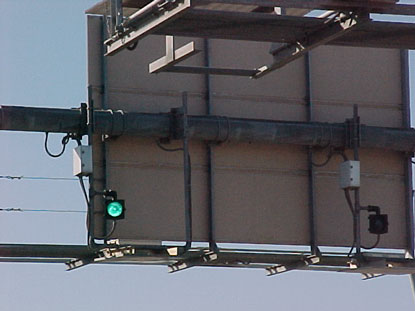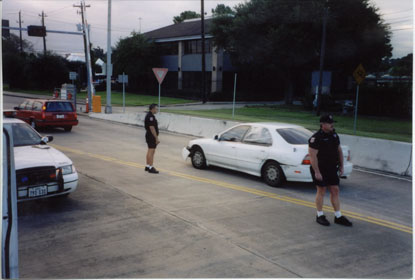|
|
|
MANAGED LANES: A Cross-Cutting Study
Chapter Four. Managed Lanes Case Studies: Project Development and Operation
In this chapter the study team has documented several key areas identified from the case study projects highlighted in the previous chapter. These areas focus on the development and operation of managed lanes projects, particularly the planning, analysis, and life-cycle considerations of an actively managed facility.
While there are a number of factors that determine the success of managed lanes throughout the planning, design, and operation of a facility, all factors must ultimately support the specific goals and objectives of the project, and implementation must focus on achieving these project objectives. Each project is unique and reflects the characteristics of the particular corridor and the desires of the community.
The key areas covered in this section are
- Planning and Coordination
- How have the projects in operation developed within the context of the regional transportation planning process?
- How have multiple agencies and private entities been involved in these projects?
- Selection and Analysis of Lane Management Strategies
- How have pricing, vehicle eligibility, and access control been used as operational strategies on managed lanes?
- What factors were considered in the selection of strategies?
- How have these strategies worked in achieving project objectives?
- Active Management and Life-Cycle Considerations
- What does "active management" mean in the context of managed lanes?
- What are the key elements for actively managing a facility over its life?
- How have the case study projects used active management in their operational approach?
- Public Outreach and Education
- What has been the role of public education and outreach for managed lane projects?
Planning and Coordination
The successful projects have been the cooperative efforts of various agencies from the initial stages of project development throughout operations. These projects are large undertakings that required the assistance of several agencies. They have frequently crossed jurisdictional boundaries. Planning for the managed lanes projects has required input from the federal agencies, the state department of transportation, the metropolitan planning organization and other local agencies.
LONG-RANGE PLANNING
None of the operating pricing projects highlighted in this study were developed out of the long-range plan for the community. In the case of the existing HOT lanes, implementers had the benefit of having HOV as part of the long-range plan. The SR 91 Express lanes were originally planned as HOV lanes but financial circumstances caused the project to be developed as HOT lanes. The New Jersey Turnpike is the result of forward-thinking politicians working with local entities to make the project happen. Even before the dual-dual section opened in 1966 there was recognition that traffic could be better managed by separating vehicle types. In the 1940's designers envisioned controlling access to facilitate the movement of goods and people through the state of New Jersey.
Now that the pricing projects have been in operation for several years, agencies are able to learn from past experiences and incorporate findings into updated long-range plans. In the San Diego region, managed lanes and HOV improvements and expansion are important components of the recently adopted regional transportation plan, Mobility 2030. The plan includes a managed lane/HOV network to allow transit and HOV to operate on congestion-free highways thus making transit more competitive with car use as a transportation mode.
A major policy objective of the plan is to achieve double-digit peak-period mode share for transit. Planners believe that an extensive managed lane/HOV network can achieve this goal. Furthermore, HOV lanes have been an important element in a number of regional plans in California due to non-attainment requirements coupled with the role of the California Air Resources Board in reducing non-point source emissions. For these reasons, managed lanes with HOV preference are included in the plan for I-15, I-5, I-805 and SR 54. Additionally, the transportation plan calls for the utilization of the managed lanes during the off-peak periods for goods movement throughout the region.
Adding managed lane facilities to the regional transportation plan is due in no small part to the previous operational success of the I-15 Express lanes and the public's acceptance of pricing. Currently, the project partners are working together to expand the HOT lanes currently in operation to a more robust managed lanes facility. Flexibility is being built into the planning and programming of the facility to allow for operations to be adjusted to meet the changing needs of the traveling public in the corridor.
CORRIDOR PLANNING
The case study projects did not require any special efforts with respect to environmental review and approval above and beyond the traditional process. The I-15 and the Houston HOT lanes, which were originally built with Federal Transit Administration (FTA) funding participation, required review and approval from FTA. In those cases the emphasis on maintaining a high level of service for transit was reflected in the operational requirements that mandated no degradation in transit service. The fact that revenues in both cases are returned to transit operations and transit improvements supports the FTA's position.
To date, specific analysis tools used for project planning have not been developed. In the case of underutilized capacity on HOV lanes, planners and engineers have relied on experience and careful monitoring of roadway conditions to fine-tune an operational strategy. Traffic and revenue studies utilize planning models to provide freeway and ramp volumes to aid in an operational assessment. Likewise, surveys and focus groups can provide information on motorists' willingness to pay tolls and potential driving habits, which offer insight into applicable toll rates.
COOPERATION WITH OTHER AGENCIES
The QuickRide program, the I-15 Express lanes and the SR 91 Express lanes are projects that were undertaken as part of the Federal Highway Administration's Value Pricing Pilot program. Implementation of these projects required close coordination with FHWA, the departments of transportation and local agencies. It has been demonstrated that it is necessary to maintain this coordination to allow for expansion of these programs and assessment of operation changes.
In addition to the traditional agency coordination, the case studies have shown that a recommended practice is to include as many potentially affected stakeholders as possible and to include them as early as possible. Others to be included, based on project experiences, are:
- Transit agencies,
- Regional transportation authorities,
- Toll agencies,
- Law enforcement personnel,
- Court personnel,
- Environmental groups,
- Special interest groups, and
- Citizens.
These groups and individuals were involved in the QuickRide program, the I-15 Express lanes and the SR 91 project to identify issues that may not be addressed by the more traditional transportation planning agencies. Careful coordination in the early stages of the projects helped eliminate potential pitfalls later in the projects.
Additionally, as technology evolves the New Jersey Turnpike Authority (NJTP) is working with other toll agencies and project partners to make travel seamless to the customer. The corridor exists primarily to serve long distance trips. In fact, 35 percent of its toll revenue is derived from out of state motorist. The New Jersey Turnpike Authority participates in a regional consortium with four other transportation agencies, including the Delaware Department of Transportation, the New Jersey Highway Authority, the South Jersey Transportation Authority and the Port Authority of New York and New Jersey. These agencies are also part of a larger group of agencies on the East coast that work cooperatively to promote mobility for the entire region.
INSTITUTIONAL ARRANGEMENTS
Just as important as the cooperative efforts of agencies, are the institutional arrangements that define the scope and the operation of the project. The institutional arrangements surrounding the construction and subsequent operation of SR 91 Express lanes by a private entity was the first of its kind. As noted previously, the facility was built on state-owned right-of-way that the company leased from the state of California. When the franchise agreement terminated after 35 years the facility would revert back to the state. As such, the facility would become part of the state highway system; therefore, the company was obliged to construct the facility to statewide standards and specifications. The private company was also responsible for negotiating with the California Highway Patrol to provide enforcement on the facility.
Caltrans and the local agencies, including Orange County and Riverside County, worked with CPTC to develop a franchise agreement. CPTC designed and built the facility in the median of State Route 91 on right-of-way owned by the state. However, the non-compete clause caused frustration amongst all parties involved and the public was extremely upset in what they saw as a lack of responsiveness by a pubic agency. Caltrans was prohibited from making other improvements in the corridor that might possibly reduce traffic on the toll lanes. Consequently, the public became more and more dissatisfied as traffic conditions in the corridor worsened. Now that a public entity owns the facility it is expected that relations between all agencies will improve.
The I-15 Express Lanes and QuickRide are somewhat different in that the lanes previously operated as HOV lanes and most institutional arrangements were already in place. In the QuickRide program the lanes used are foremost HOV lanes that are operated and enforced by the transit authority. The lanes must operate according Houston Metro's Transitways plan. Additionally, the lanes were constructed by TxDOT but Federal Transit Administration (FTA) funds were also used for pay for construction. This has been cited as one reason that SOVs are not allowed on the lanes. This would trigger a repayment to be made to FTA for the funds expended. Expansion plans for the Katy Freeway, as discussed later in the report, will also require more institutional arrangements with other entities.
Selection and Analysis of Lane Management Strategies
The lane management strategies employed on the four case study projects vary depending on (1) the objectives of the project, (2) whether the strategy is implemented on new capacity or an existing facility, (3) the availability of right-of-way, (4) current operational characteristics in the corridor, and (5) environmental and societal concerns. Each of three primary strategies — pricing, vehicle eligibility, and access control — are reviewed below from the standpoint of how lane management strategies were analyzed and selected.
PRICING
Pricing has been employed as a lane management strategy in an effort to manage demand and to make use of underutilized capacity. Value pricing is the nationally endorsed and recognized overview term currently applied to a system of fees or tolls that vary according to the level of congestion on a roadway facility. Higher tolls are usually charged when congestion is heaviest and delay is at its worst.
The Role of Pricing in Project Planning
In the following section each of the case studies will be examined from the standpoint of how pricing was utilized to achieve project objectives.
Project Objective: Private Funding Opportunity
The SR 91 Express lanes provide an example of several agencies taking advantage of circumstances to provide travelers in the corridor with more travel options without spending public dollars. The SR 91 Express lanes were originally planned as HOV lanes to be constructed in the median of SR 91 by the California Department of Transportation (Caltrans) in an effort to relieve the extreme congestion in the SR 91 corridor. However funding was unavailable from federal and state sources. Voters had twice defeated proposals to use bonds and special tax incentives to build the HOV lanes. This led Caltrans and the local agencies to explore other options. Assembly Bill 680 had recently been signed into law that encouraged public-private partnerships to help meet the funding crisis. The law authorized and encouraged the state to actively seek partnerships with the private sector to implement projects and allowed the private partners to charge tolls on the facilities to receive a return on their investment. Eventually, California Private Transportation Company (CPTC), a private company, offered a proposal to plan, finance, construct, operate, and maintain the facility. CPTC proposed four express lanes as a toll road with free or reduced costs to certain user groups.
The SR 91 project was implemented in a corridor that was severely congested and motorists had very few options in dealing with congestion. The project was, and still is, marketed as providing an alternative to adjacent mainlanes of SR 91 (Exhibit 10). The motorists may choose to pay a toll and by-pass the congestion or determine that one can "afford" the time lost on the congested mainlanes.
Pricing as a lane management strategy for the SR 91 facility was planned to achieve a return on the investment for CPTC. Detailed traffic and revenue studies and data on motorists' travel habits were used to analyze and evaluate pricing as a management strategy.
Project Objective: Sell Capacity to Fund New Transit Service
On the I-15 Express lanes, the plan for pricing the HOV lanes was a result of excess capacity on the HOV lanes as well as a need to provide better transit service. Planners initiated studies to assess the viability of allowing single occupant vehicles (SOV) access to the lanes by paying a toll. The San Diego Association of Governments (SANDAG) also realized that transit users in the corridor were underserved. Managed lanes per se, were not specifically mentioned in the regional mobility plan at the time the project was initiated. However, with specific objectives in mind SANDAG applied for a grant under the FHWA Value Pricing Pilot Program. The project objectives included:
- Making better use of available capacity in the HOV lanes and
- Generating revenue to fund transit and HOV improvements in the corridor.
Careful study of the pilot project was conducted. Traffic conditions and roadway conditions were used to determine if the project objectives were being met. Additionally, state legislation authorizing the program mandated that the level of service (LOS) on the facility could not be degraded as a result of the program.
Project Objective: Allow Additional Users in the HOV Lane While Maintaining High Speed Transit Service
The QuickRide program in Houston also makes use of excess capacity on the HOV lanes on I-10 and US 290. The transit authority has worked with local, state and federal agencies to plan, build and operate an extensive HOV system as part of a plan to keep people moving throughout the Houston area. The Katy HOV lane was originally built as a traditional HOV lane as part of the HOV system although travel was initially restricted to buses and registered vanpools only. The severe restrictions led to under use of the facility and gradually requirements for the facility were relaxed to 2+ carpools. This caused traffic on the facility to grow and the lane eventually became congested. In an effort to address the congestion, 2+ carpools were eliminated from lane eligibility. This caused a 30 percent decline in the number of people moved in the peak hour. The Metropolitan Transit Authority of Harris County (METRO), working with the Texas Department of Transportation (TxDOT), and FHWA implemented value pricing on the facility to manage the demand while maintaining the travel time advantage of the HOV lane for buses. METRO has a policy to maintain speeds of 50MPH on HOV lanes.
Many of the same issues were encountered on the Northwest Freeway as well. This particular facility was designed to encourage transit uses since most of its access points are through transit stations or park-and-ride lots. The deteriorating service on this route and the impact on bus operations resulted in delays, reduced bus reliability and schedule adherence and customer complaints. METRO officials noted the success of the QuickRide program on the Katy freeway in achieving specific objectives and concluded that the program could restore travel time benefit to the Northwest HOV lane during the morning peak. The QuickRide program on the Katy Freeway had increased the number of 3+ carpools during the peak and redistributed the 2-person carpools to outside the peak. The program also successfully increased the average operating speed while moving the same number of people. METRO engineers determined that the program could have the same effects if implemented on the Northwest Freeway.
Project Objective: Shift Traffic Demand Out of the Peaks
Initially, two different toll structures on the New Jersey Turnpike were a reflection of the higher costs of construction in Northern New Jersey. More recently, variable pricing has been used to shift traffic out of the peak period and to encourage the use of the electronic toll collection technology, E-ZPass. The turnpike serves long-distance commuter trips and planners and engineers recognized this by building an HOV lane as part of a widening project that operates as an HOV only during the peak periods.
Design Issues Associated with Pricing
Facilities that were converted from HOV lanes to HOT lanes did not have the ability to include a provision for pricing when the original facility was designed. The New Jersey Turnpike and SR 91 were both designed as toll roads enabling accommodations to be made for pricing. However, as conditions in the corridor change and operating strategies are modified, the design of a facility becomes important in assessing the available strategies.
Conversion of HOV Lanes to HOT Lanes
The I-15 Express lanes and the QuickRide program approached pricing from the standpoint of an existing facility. Both programs were implemented on currently existing reversible, barrier-separated HOV facilities. The design elements of the project were already in place. Moreover, QuickRide and the I-15 Express lanes took advantage of existing technology in the corridor. Automatic Vehicle Identification (AVI) readers were already in place on the Katy freeway as part of the freeway management system. METRO was able to minimize costs because the hardware was already in place on the facility for electronic toll collection. A similar situation existed on the I-15 HOV lane allowing SANDAG to implement the FasTrak system of electronic toll collection. The projects in California and Houston each have positive barrier separation between the priced and un-priced lanes either with concrete barriers or plastic pylons. Likewise, each has very limited access and egress points. These design features aid in enforcement of the facility.
New Facility within an Existing Freeway
On SR 91 CPTC designed and built the facility in the median of State Route 91 on right-of-way owned by the state. The company negotiated a 35-year lease with the state after which ownership of the facility reverted back to the state. One important provision of the franchise agreement was the "non-compete" clause that prohibited Caltrans from making roadway improvements in the corridor that may draw traffic from the Express lanes.
The private developers of the project began the design of the facility with certain parameters already in place. They knew that electronic toll collection was needed so the facility was designed to accommodate this. Since the project was to be constructed in the median of a freeway, available right-of-way was an established parameter in the design. Lastly, traffic and revenue studies helped the company decide that demand was high enough in the corridor and that motorists had enough willingness to pay that two toll lanes were warranted in each direction.
Operational Issues Associated with Pricing
Electronic Toll Collection and Enforcement
An important component of pricing operations is the ability to assess the tolls electronically. "Back office" account administration and violation processing support this effort. When an account is opened and a transponder is issued, information such as name, address, vehicle make and model and license plate number is entered into a database. The account holder may also supply financial information allowing the account to be automatically replenished when the balance drops to a certain level. On I-15 when a transponder passes a reader the information is transmitted electronically to a central processing center. If the reader does not detect a valid account a light signals this to the enforcement officers stationed at the tolling zone located within the facility, as shown in Exhibit 11. The officer may then proceed to issue a citation.
The same type of account administration is used on the SR 91 Express lanes. In fact, California state law mandates that all electronic toll collection technology in the state be interoperable. Hence, the same marketing name is used on both facilities.
In addition to automated account administration, SR 91 also uses automated enforcement technology. When a reader cannot detect a tag or detects an invalid tag read, it triggers a camera that takes a photo of the vehicle's license plate. Exhibit 12 is a picture of photo violation enforcement camera. The license plate image is matched against the database records to ascertain if the motorist does, in fact, have a valid account. If the system determines that there is no record of an account with that license plate number, the state motor vehicle records are searched to determine the registered owner of the vehicle. The owner is then sent a citation requesting the toll amount plus administrative fees.

Exhibit 12. Enforcement Camera.
On the I-15 Express lanes, SANDAG contracts with a private provider that handles the administration of the program. OCTA has contracted with the former facility owners to continue providing this service on SR 91. METRO handles account administration in-house and also has its own police department to facilitate enforcement. The New Jersey Turnpike employs a similar system using E-Zpass although this system does not include automated enforcement.
Preferential Users
Each of the case study projects employs a different pricing strategy. The QuickRide program and the I-15 Express lanes each identified preferential user groups and structured the pricing strategy to support this objective. Initially, the SR 91 Express lanes also provided preferential treatment to HOVs by way of a discounted toll but this strategy had to be balanced with the objective of generating sufficient revenues to provide a return on investment for the private developers. Subsequently, this pricing strategy was later adjusted. The New Jersey Turnpike has recently adopted pricing strategies that attempt to spread demand rather than having it concentrated in the peak. In each case, the project partners developed a pricing strategy that aided in achieving project objectives. Exhibit 13 demonstrates the different pricing strategies and HOV preference for each of the facilities.
| FACILITY | Variable Pricing | Dynamic Pricing | Fixed Pricing | HOV Preference | Type of Facility |
|---|---|---|---|---|---|
| SR 91 Express Lanes | Yes | No | No | Yes - HOV3+ | Express Lanes |
| I-15 | Yes | Yes | No | Yes - HOV2+ | HOT Lane |
| QuickRide | No | No | Yes | Yes - HOV3+ | HOT Lane |
| New Jersey Turnpike | Yes | No | No | Yes - HOV lane through a portion of dual-dual section; same price as SOV | Toll Road |
VEHICLE ELIGIBILITY
Vehicle eligibility is an important tool in managing demand while meeting policy objectives. Vehicle eligibility may vary by time of day, day of week, and may change over the life of the facility as conditions change. Vehicle eligibility has not been used to regulate traffic flow on a dynamic basis, like pricing.
Planning for Vehicle Eligibility
Early planning in each of the case study projects focused on separating user groups or vehicle types. The California projects and QuickRide showed a preference for HOV: SR 91 by way of discounted tolls, and QuickRide and the I-15 Express lanes by ensuring that HOV operations were not degraded. When the New Jersey Turnpike was expanded, planners and engineers determined that separating truck traffic from passenger vehicles would improve traffic flow and safety on this section of the facility. The schematic in Exhibit 14 is a depiction of the roadway on this portion of the turnpike.
HOV Preference
In the case of I-15, which previously operated as an HOV facility with 2+ vehicle occupancy, planners and engineers determined that the HOV facility could handle a certain number of SOVs vehicles on the facility. The program began very modestly with windshield stickers offered on a first-come, first-served basis, and gradually evolved to the system in place today.
Before the QuickRide program was implemented, Houston METRO had experimented with changing occupancy requirements. By allowing HOV 2s to pay a toll, agencies sought to better utilize the excess capacity on HOV lane that was a result of a 3+ restriction. Doing this also improved traffic flow in the adjacent general-purpose lanes. As in the case of the I-15 Express lanes, the QuickRide program began by issuing a set number of "passes" to allow HOV2s onto the facility. Assessments of roadway conditions, traffic volumes, and expected demand concluded that the single HOV lane could not accommodate the demand that would be created if SOVs were allowed access onto the facility.
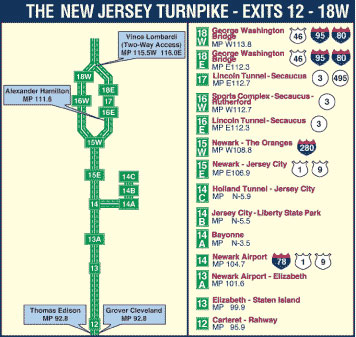
Exhibit 14. Schematic of Separate Truck Lanes on New Jersey Turnpike (9).
SR 91 does not specifically use vehicle eligibility as a qualification for admission to the Express lanes. However, the former operators and the current operators each offered either free or discounted service to HOVs.
Designing for Vehicle Eligibility
In New Jersey, on the dual-dual facility, agencies identified increased safety related to heavy vehicle collisions as an objective and sought to achieve this by separating heavy-duty vehicles from light-duty passenger vehicles. The facility was designed in such a manner as to effectively manage the different vehicle types. The I-15 Express lanes as well as the two facilities in Houston were designed as HOV lanes to be accessed according to vehicle occupancy. Each of these three projects uses concrete barriers to separate eligible express vehicles from other vehicles.
Separating Trucks
The New Jersey Turnpike is the only operating managed lane facility that was designed specifically for the purpose of separating vehicle types. The other facilities typically do not allow commercial trucks onto the facilities. The inside lanes of the dual-dual roadway on the New Jersey Turnpike are reserved for automobiles only while the outer lanes accommodate all vehicles types. These lanes are separated from the outer lanes by concrete barriers. Exhibit 15 is a picture of the signing on the turnpike. Each part of the roadway has its own entrance and exit ramps. Between Interchanges 11 and 14, the left-most lane of the outer roadway is designated as a HOV lane between the hours of 6 a.m. and 9 a.m. in the northbound direction and between 4 p.m. and 7 p.m. in the southbound direction. The HOV lanes are reserved for cars and vans carrying three or more persons and to all buses and motorcycles. These lanes act as general-purpose lanes at times other than the peak and are open to all traffic.
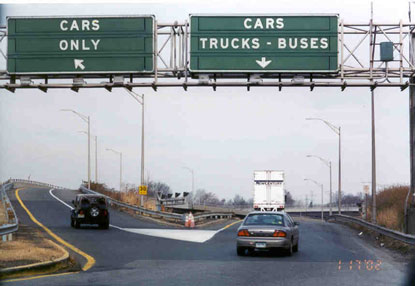
Exhibit 15. Signing on New Jersey Turnpike.
The dual-dual portion of the New Jersey Turnpike clearly demonstrates the operational and safety benefits of separating vehicle modes. Having the entrance to a HOV or passenger-car exclusive facility located in the center of a corridor without a dedicated ramp requires vehicles to weave across each of the general purpose lanes. The direct access to each barrel provided on the New Jersey Turnpike eliminates this weaving maneuver (which promotes a safer and more operationally efficient system). Maintaining similar geometric criteria for both barrels also provides greater flexibility in moving traffic between the barrels as needed for incidents and maintenance. Douglas' (18) finding that the dual-dual portion has lower crash rate, shown in Exhibit 16, supports separating trucks and passenger cars.

Exhibit 16. Crash Rates on New Jersey Turnpike (18).
Operations with Specialized Vehicle Eligibility
Operating a facility based on vehicle eligibility has been challenging from the perspective of allowing vehicles of varying occupancies access to a facilities. In many instances this has required separate lanes to allow for visual inspection of the vehicle to determine the number of occupants. When operations are based on vehicle eligibility, enforcement becomes critical in preserving the integrity and proper operation of the facility.
The I-15 Express lanes operate with consistent occupancy requirements as does the New Jersey Turnpike. SR 91 does not have occupancy requirements but now offers free travel to HOV 3+ at all times except in the PM peak when the toll is discounted 50 percent. However, the QuickRide program changes occupancy requirements based on time of day. HOV 3+ may travel on the facilities free of charge at any time. HOV2s are assessed the $ 2.00 when the QuickRide program is in effect at certain times of the day. The varying occupancy requirements have made signing on the facilities more complex. Exhibit 17 is an example of a dynamic message sign on the Katy Freeway. The signing must communicate several messages to the driver, such as eligibility requirements, occupancy requirements, times of eligibility, and that travelers must have an established QuickRide account and be equipped with a transponder.
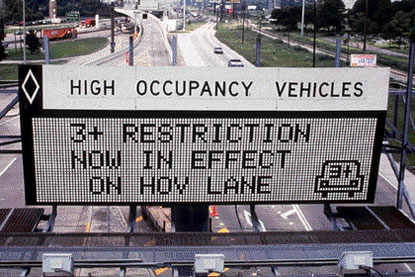
Exhibit 17. Dynamic Message Sign.
In the case of the QuickRide program participants are issued a hangtag to indicate their participation in the program. To date, approximately 2,000 motorists have registered to participate in QuickRide; however, only about 10 percent of these motorists use the facility at any given time.
Enforcement
The QuickRide program is somewhat unique in that enforcement services are provided by the transit authority. Houston METRO, the transit authority, operates the program on the TxDOT facility because they are the operators of the HOV system. METRO provides enforcement with its own police department. Enforcement is conducted by METRO police as vehicles enter the facility (Exhibit 18). Enforcement in the QuickRide program is very complex. Enforcement officers must verify occupancy, confirm that the vehicle has a transponder, and look for the QuickRide hangtag. Additionally, technology is not currently used to assist in toll accounts verification because the pilot project was developed using technology in place at the time. Plans are underway to upgrade the enforcement operation with additional technology. Transponder violations such as invalid reads or inactive or deficit accounts have resulted in violation rates that are higher than expected.
Enforcement on the I-15 Express lanes is provided by the California Highway Patrol (CHP) and supported with revenues generated from the project. SANDAG contracts with the CHP to provide this service which is usually performed on a voluntary over-time basis by off-duty officers. Enforcement officers are stationed at the entrance to the facility. Officers are also notified by a light if a solo driver's transponder does not register. FasTrak customers make up roughly 25 percent of the vehicles on the Express lanes; the rest are HOVs or transit. Occupancy violation rates on the facility are low at less than 5 percent. California law provides for a stiff penalty for violating occupancy requirements beginning at $ 341.00. The courts are very diligent about upholding these fines. Toll violations begin at a minimum of $ 20.00 for toll evasion.
The CHP also provides enforcement on the SR 91 Express lanes facility at the operators' expenses. The CHP visually inspects vehicles for occupancy and relies on photo enforcement for toll collection. Additionally, California state law also mandates that all vehicles be equipped with a FasTrak transponder that is properly mounted. Toll evasion fines for this violation begin at $ 100.00 for the first offense and increase to $ 500.00 for the third offense within a year. Three enforcement areas are located along the facility.
On May 19, 2003, OCTA instituted a new policy allowing HOV 3+ to travel for free at all times except for the eastbound PM peak; a discounted toll is assessed at this time. To aid in enforcement, carpoolers are directed to a specific lane as they pass through the tolling zone. Depending on the time, a toll may or may not be deducted from the motorist's account.
In New Jersey, the Turnpike rules and regulations are enforced by 214 state police patrols that are assigned exclusively to the Turnpike. These patrols are funded with toll revenues. In fact, the authority receives no state tax money and actually contributes $ 12 million annually to the state transportation fund.
The case studies indicate that enforcement is primarily facilitated by the presence of dedicated law enforcement officers, and secondarily by the design of the facility (presence of enforcement areas and no or few intermediate access points). Moreover, violation rates are lowest when enforcement officers have minimal tasks to perform (e.g., occupancy verification only versus occupancy coupled with tag verification) and are assisted by technology.
ACCESS CONTROL
Access control is used to limit entry to a facility based upon facility congestion levels or operational conditions, such as an accident or maintenance needs. In this case, access is not restricted by type of user. Facilities may limit access by having fewer entrance and exit ramps, using grade-separated ramps as opposed to at-grade access, or the facility may have actual barriers at ramp locations to control access.
Planning and Designing for Access Control
The New Jersey Turnpike is probably the best example of an operating facility that has successfully employed access management as a lane management strategy. Even back in the 1940's when the "superhighway" was under design, engineers established a standard of 70-75 MPH design speed, determined that the facility would be a controlled-access facility and that interchanges would be widely spaced. The New Jersey Turnpike serves long-distance trips. In contrast, the other case study projects serve more commuter-type trips. When the QuickRide HOV lanes and the I-15 HOV lanes were converted to HOT lanes, plans for access control were already in place since the lanes were separated from adjacent traffic as HOV lanes. The Northwest Freeway HOV lane was designed to encourage transit use since most of its access points are through transit centers or park-and-ride lots. The designers for the SR 91 Express lanes determined that the facility would operate better if there were no intermediate access points.
Since, the Express lanes on I-15 and SR 91 have no intermediate access points, they act as pipelines funneling traffic past congested general-purpose lanes. The QuickRide projects do offer intermediate access. However, each of these projects utilizes positive separation such as concrete barriers or pylons to separate the lanes from adjacent traffic. Positive separation tends to minimize the opportunity for intermediate access points.
Operations with Access Control
The gates of the New Jersey Turnpike were designed to allow for greater flexibility in managing the facility during major incidents. Each part of the roadway has its own entrance and exit ramps and there are periodic openings, equipped with gates, in each of the roadways to allow traffic to be diverted from one facility to the other as conditions may warrant. Traffic surveillance cameras and an integrated system of ITS applications relay information to the Turnpike Operations Center in New Brunswick. From there, the system controls changeable message signs, lane use signs, and hazard warning signs to alert motorist to congestion, incidents and adverse weather conditions, as shown in Exhibit 19.

Exhibit 19. New Jersey "Roadway Congested" Sign.
Volume on the turnpike varies greatly across the 148 miles. Traffic is typically lightest on the four-lane section between Exit 1 and Exit 4 with an average of 40,000 vehicles per day. The fourteen-lane section between Exit 11 and Exit 14 carries approximately 200,000 vehicles per day. The gates allow sections of the facility to be closed or opened to accommodate traffic as needed.
Caltrans also works cooperatively with SANDAG to deal with incidents that occur in the I-15 corridor. When an incident occurs on the Express lanes SOVs are not charged the toll. If an incident occurs on the mainlanes that delays traffic for more than an hour Caltrans has the authority to open the Express lanes to all traffic. When this occurs no tolls are charged to any motorists.
In the event of an incident or breakdown on the SR 91 Express lanes motorists are advised to try to reach one of the three enforcement zones or pull to the far left shoulder. Thirty-five cameras are located along the facility to monitor traffic. Customer service patrols generally patrol the lanes between 5:00am and 9:00pm Monday through Friday and at peak hours on the weekends. The CHP also has the authority to open the Express lanes to all traffic in the event of severe incident on the mainlanes.
Active Management and Life-Cycle Considerations
A primary difference between managed lanes and other more traditional forms of lane management is the notion of "active management." As conditions in a corridor change or the objectives of a community change, the operational strategy of a facility may need to change in order to continue to meet pre-defined objectives.
It is important to recognize and communicate the possibility of change as the project is developed. Each of the case study projects has evolved over time. The I-15 Express lanes and the QuickRide projects began as HOV lanes with varying occupancy requirements. Conditions in the corridor changed such that changes in operational strategies were implemented. The operator of a managed lanes project recognizes the life-cycle characteristics associated with the facility and expects that operations will inevitably be modified over time. The key to ensuring the success of the managed lane facility is the development of performance expectations and operating thresholds for the facility, and clearly communicating the active management premise to policy-makers and the public.
The Colorado Department of Transportation has developed a graphic that illustrates a life-cycle operation for a proposed managed lane facility on I-25. Exhibit 20 depicts at which stage various strategies will be enacted. In this scenario, SOVs are permitted access to the managed HOV lane, provided they pay the prevailing toll. Through the use of dynamic pricing, which varies the toll with the level of congestion on the managed HOV lane, the number of SOVs who use the facility is never allowed to exceed the critical operating threshold.
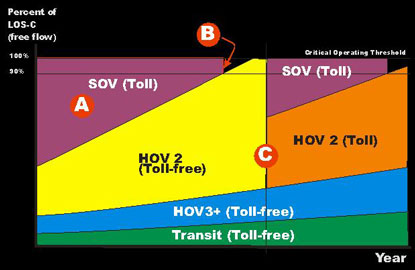
Exhibit 20. Life-Cycle of a Facility (10).
As depicted by point A on the figure, HOV traffic growth over time reduces the availability of capacity for toll-paying SOVs. At such a point where the prevailing toll charge would exceed a reasonable charge (point B), SOVs would no longer be permitted access to the managed HOV lane. When the growth in HOV traffic exceeds the critical operating threshold, authorities would once again change the occupancy policies for the facility. However, as shown by point C, the excess capacity is sold to both two-person carpools as well as single-occupant vehicles. In the managed HOV lane scenario, excess capacity is regulated to ensure a balance between maintaining free-flow conditions and avoiding the "empty lane syndrome." Therefore, the excess capacity is much more effectively utilized, further enhancing the overall effectiveness of the managed HOV facility.
FLEXIBILITY
It is important to note that successful projects have the flexibility to alter operations as conditions warrant and priorities change. The two managed lanes facilities in California offer the flexibility of variable and/or dynamic tolling. The New Jersey turnpike has added HOV lanes in the past, is now offering discounted tolls to motorist not traveling in the peak, and is building more direct access to transit. The QuickRide program does not have the ability to easily alter operations in response to demand. As managed lanes projects are mainstreamed, planners and engineers are learning the advantages of including flexibility in the design of a facility. By including flexibility as a design element the facility's life may be extended because operations on the facility can be changed as traffic conditions in the corridor change or as community objectives for the project change.
THRESHOLD VALUES
Inherent in the premise of active management is necessity for establishing threshold values for maintaining a prescribed level of operating service. That threshold value could be based on traffic volumes, operating speed, or similar measure. In the case of the Colorado diagram, a "critical operating threshold" is established, which when exceeded triggers an action to modify the lane management strategies - whether that be price or occupancy or both - in order to maintain operating objectives.
At its inception, SR 91 used traffic and revenue studies to determine traffic volume threshold values that would allow conditions to remain free-flow at 50 MPH and that would generate enough revenue to provide a return on investment to the private company that financed, built and operated the facility. Now that the facility is owned by a public agency priorities may change and the thresholds may also change. OCTA is planning for improvements to the SR 91 mainlanes and this could impact the operation of the Express lanes. Additionally, OCTA has established a new toll policy that clearly defines the triggers of toll increases or decreases for the peak hours as defined in the toll adjustment goals. The goals are to:
- reduce the likelihood of congestion by diverting traffic to other hours with available capacity,
- maintain free flow travel speed in the 91 Express lanes,
- maintain travel time savings,
- accommodate projected growth in travel demand, and
- ensure that the toll road generates sufficient revenue to effectively operate the toll lanes and maintain a strong debt service position (11).
These triggers are based on the traffic volumes in the Express lanes. The traffic volumes are monitored on hourly, day of the week and direction over a 12 consecutive week period. If at any time during that period traffic volumes reach or exceed 3,128 vehicles per hour, per day, or per direction this occurrence is flagged. This volume was identified as that maximum amount of traffic that can be accommodated while maintaining and operating speed of 50 mph in the express lanes. If this happens six or more times during the 12-week period the second step in the toll adjustment policy is initiated. The second step in the process further analyzes the data to determine the amount of the toll rate increase. Exhibit 21 illustrates the toll rate setting parameters.
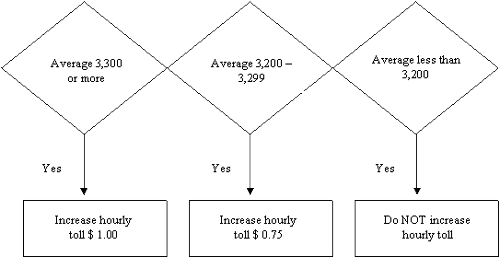
Exhibit 21. Parameters for Setting Toll Rates (11).
Any toll increase or decrease will stay in effect for six months at which time the process is repeated. Additionally, non-peak hour tolls will be adjusted annually for inflation. The Inflation Factor will take effect beginning July 1, 2004 and at the beginning of each fiscal year (July-June) thereafter. The Inflation Factor will be applied to non-peak hour tolls as well as peak hour tolls that were not adjusted using the process described above in the previous 12 months.
SANDAG established critical operating thresholds for the I-15 Express lanes by establishing parameters for operations that included specific level of service requirements so as to not adversely impact the HOVs on the facility. The capacity of the Express lanes is 1,525 vehicles per half hour and the toll is adjusted dynamically to ensure the capacity is not exceeded. The QuickRide program uses bus operating speeds for threshold values. The project partners there established the policy of maintaining bus operating speeds at 50mph.
HIERARCHY OF USER GROUPS
Determining a hierarchy of users may be an important goal for a managed lanes project. Each of the pricing projects in California and Texas has chosen to give preferential treatment to HOVs. On the I-15 Express lanes and on the QuickRide project very specific parameters have been established so as not to adversely impact the HOVs that travel on these facilities. The QuickRide program gives priority to transit vehicles and ensures that the operating speeds of buses are not compromised by the HOV2s allowed on the facility. The I-15 Express lanes' parameters have been defined by state law. Level of service requirements must be maintained for HOVs on the facility. In addition, SANDAG dedicates all excess revenue generated by the Express lanes to fund transit service in the corridor.
Communities that have a goal of increasing person movement through the use of transit and HOVs will continue to provide preferential treatment to these groups either through price or by providing improved access. For example, as SANDAG considered pricing for the I-15 HOV lanes, data showed that transit users in the corridor were underserved. Therefore, SANDAG decided to dedicate revenues to providing transit service in the corridor. The Inland Breeze, as shown in Exhibit 22, is funded with revenues from the project. Direct connect ramps for the exclusive use of transit and HOV may provide a higher level of access to a managed lane facility. These treatments are being planned on the New Jersey Turnpike. With new managed lane facilities coming on line, operators will need to establish a hierarchy of users and design and manage the facility to maximize the convenience offered to these users.
MONITORING AND EVALUATION
Under a premise of active management, the need for continual monitoring and evaluation of the managed lanes is imperative. At the outset of a project, specific performance measures are defined and throughout the life-cycle of a project the measures are monitored and evaluated. I-15 did this when it established a performance measure of level of service (LOS) C and set that threshold at 1,525 vehicles per half hour. SR 91 Express lanes operators have raised tolls several times as a result of increased congestion on the facility and in effort to maintain free flow condition and return a profit. The new owners have established very clear objectives and set forth a policy that premises those objectives and the monitoring and evaluation of the facility.
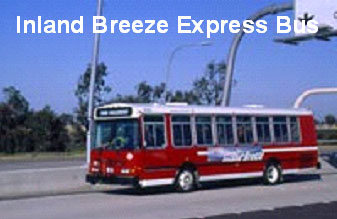
Exhibit 22. Inland Breeze (12).
Monitoring technology used successfully today include vehicle sensors, automatic vehicle identification, license plate recognition, and user information systems. Each of these components has been demonstrated in the case studies to be integral in ensuring smooth operation of a facility. The New Jersey Turnpike uses an extensive array of ITS technologies to monitor the turnpike. This enables operators to assess when, if or how operations need to adjusted.
Likewise, more comprehensive, historical data must be collected and analyzed to determine if adjustments to the overall operating strategies should be made. Population, employment and land use changes will occur in the corridor over time. As a result, conditions on the facility will also change. These data will be necessary to make an accurate assessment of conditions on the facility. The conversion of the HOV lanes to HOT lanes in the case studies relied on operations data and the experience of staff with roadway conditions to make those operational changes. The New Jersey turnpike recently implemented variable pricing in an attempt to shift traffic out of the peak periods because data indicated these were the most congested times.
The I-15 Express lanes and the QuickRide project each identified specific performance measures at the outset of the project. This has aided in conducting an objective analysis of the project and whether or not it is achieving the objectives set forth.
Public Education and Outreach
Public education and outreach has been proven critical to the success of managed lanes projects. The outreach has taken many forms. SANDAG, CPTC, and Houston METRO all conducted surveys and focus groups to conduct market research prior to implementation. This information was used to develop materials to educate and inform travelers of the projects. The SR 91 Express lanes benefited and implementation was aided by a political champion that advocated on behalf of the project. Additionally, political champions have supported enabling legislation for the projects in California.
PRE-PROJECT EDUCATION
The SR 91 Express lanes offered many new innovations that were unfamiliar to the public. Since the beginning of project planning, CPTC conducted extensive traveler surveys and focus groups regarding the pricing concept and traveler reaction to dynamic pricing. In fact, the information gathered throughout this process impacted the way the company conducted operations. Additionally, the project was championed by several prominent political leaders.
Once the commitment was made to pursue congestion pricing, the project sponsors involved the media. This project has been highlighted and spotlighted around the world because of its innovation. This was the first effort of road pricing in the United States; it was the first fully automated toll road; and it was the first demonstration of using pricing to affect travel behavior. These reasons naturally drew media attention to the project. The project sponsors took a proactive role in educating the media and public to the project objectives and possibilities. They issued press releases, formed a speakers' bureau and made several public presentations as well as using direct mail, radio and television to alert the public to the imminent opening of the facility.
I-15 in San Diego relied on extensive public outreach prior to changing the operations of the HOV lanes. As early as 1991, then San Diego MTDB member, Jan Goldsmith, had suggested pricing as a way to utilize the excess capacity on the HOV lanes. Caltrans and SANDAG presented the public with pricing as a way of raising revenue to pay for transit improvements in the corridor while providing a transportation choice for travelers. The public was assured that excess revenue would benefit transit and HOV in the corridor. Focus groups, surveys and interviews all helped in developing programmatic strategies for the facility.
Prior to implementation of the QuickRide program a number of focus groups were held to ascertain public sentiment regarding the value pricing concept. The results of these focus groups were used to develop a marketing strategy and public information plan.
PROJECT-SPECIFIC MARKETING
The Express lanes on SR 91 and I-15 are well marketed. Recently, OCTA has made great efforts to publicize the fact the SR 91 Express lanes are now owned by a public entity. The operators also have an extensive incentive program for FasTrak patrons. The operators have teamed with local vendors to offer discounted services to FasTrak account holders. Yearly surveys have been conducted of users of the facility. Other surveys of non-users are conducted occasionally.
The SR 91 project has had to overcome controversy surrounding the franchise agreement with private owners at the same time as traffic volumes in the area continue to grow. Still, the project is favored by the public as providing a choice in travel options. OCTA has made the transition to public ownership seamless to the customer. Current FasTrak accounts were not affected by the transfer of ownership.
SANDAG markets the I-15 Express lanes and the FasTrak program. Support for the I-15 project has been enhanced because revenues generated by the project are used to support transit and HOV operations in the corridor. This objective was supported by the public and the public sees the tangible results of the project.
ON-GOING PUBLIC INFORMATION
The OCTA maintains a website for the SR 91 Express lanes that allows for on-line account applications and account maintenance. There is also a customer service center and an 800 number for customers' convenience.
Additionally, an advisory committee has been formed that includes representatives from Caltrans, Riverside County Transportation Commission, Orange County Transportation Authority, and San Bernardino Associated Governments and the general public. The group will decide if a new operational strategy is needed, what excess revenues should be used for, if preferential treatment will continue or be enhanced for HOV, and any plans for expansion of the current facility. Each of these questions will be answered relative to the objectives of the project set by the community.
The New Jersey Turnpike keeps the public informed via a website, as shown in Exhibit 23, which provides information about the turnpike as well as a link to sign-up for the electronic toll collection program, E-ZPass. The website offers toll rate calculators, real-time traffic information, traffic advisories and information about turnpike construction. On the E-ZPass website customers may apply for an account on-line or manage their account.
On-going surveys in the I-15 corridor indicate that the project is supported by the public. As part of the project study for the facility expansion, additional stakeholder interviews, focus groups and surveys have been conducted and indicate continued support of the program and enthusiasm about extending the project. Additionally, the project is supported through a website that provides information and offers on-line application, a customer service center and an 800 number to call for more information.
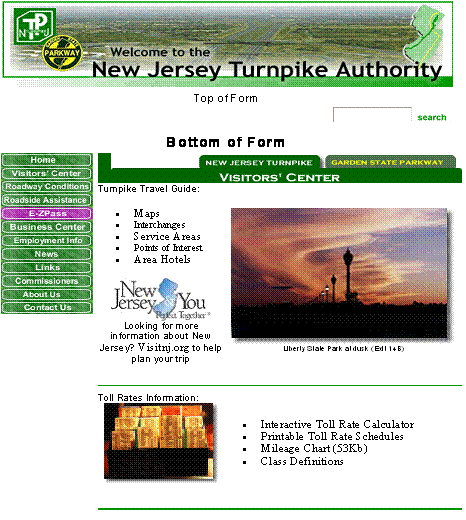
Exhibit 23. New Jersey Turnpike Web Site (13).
Previous | Table of Contents | Next

